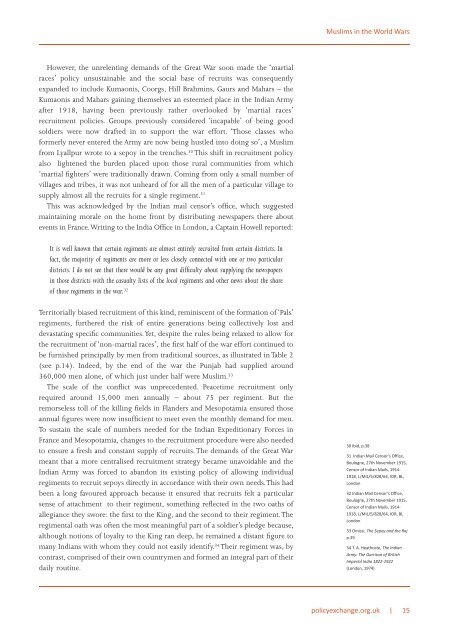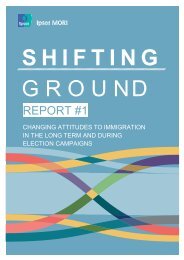Create successful ePaper yourself
Turn your PDF publications into a flip-book with our unique Google optimized e-Paper software.
However, the unrelenting demands of the Great War soon made the ‘martial<br />
races’ policy unsustainable and the social base of recruits was consequently<br />
expanded to include Kumaonis, Coorgs, Hill Brahmins, Gaurs and Mahars – the<br />
Kumaonis and Mahars gaining themselves an esteemed place in the Indian Army<br />
after 1918, having been previously rather overlooked by ‘martial races’<br />
recruitment policies. Groups previously considered ‘incapable’ of being good<br />
soldiers were now drafted in to support the war effort. ‘Those classes who<br />
formerly never entered the Army are now being hustled into doing so’, a Muslim<br />
from Lyallpur wrote to a <strong>sep</strong>oy in the trenches. 30 This shift in recruitment policy<br />
also lightened the burden placed upon those rural communi<strong>ties</strong> from which<br />
‘martial fighters’ were traditionally drawn. Coming from only a small number of<br />
villages and tribes, it was not unheard of for all the men of a particular village to<br />
supply almost all the recruits for a single regiment. 31<br />
This was acknowledged by the Indian mail censor’s office, which suggested<br />
maintaining morale on the home front by distributing newspapers there about<br />
events in France. Writing to the India Office in London, a Captain Howell reported:<br />
It is well known <strong>that</strong> certain regiments are almost entirely recruited from certain districts. In<br />
fact, the majority of regiments are more or less closely connected with one or two particular<br />
districts. I do not see <strong>that</strong> there would be any great difficulty about supplying the newspapers<br />
in those districts with the casualty lists of the local regiments and other news about the share<br />
of those regiments in the war. 32<br />
Territorially biased recruitment of this kind, reminiscent of the formation of ‘Pals’<br />
regiments, furthered the risk of entire generations being collectively lost and<br />
devastating specific communi<strong>ties</strong>. Yet, despite the rules being relaxed to allow for<br />
the recruitment of ‘non-martial races’, the first half of the war effort continued to<br />
be furnished principally by men from traditional sources, as illustrated in Table 2<br />
(see p.14). Indeed, by the end of the war the Punjab had supplied around<br />
360,000 men alone, of which just under half were Muslim. 33<br />
The scale of the conflict was unprecedented. Peacetime recruitment only<br />
required around 15,000 men annually – about 75 per regiment. But the<br />
remorseless toll of the killing fields in Flanders and Mesopotamia ensured those<br />
annual figures were now insufficient to meet even the monthly demand for men.<br />
To sustain the scale of numbers needed for the Indian Expeditionary Forces in<br />
France and Mesopotamia, changes to the recruitment procedure were also needed<br />
to ensure a fresh and constant supply of recruits. The demands of the Great War<br />
meant <strong>that</strong> a more centralised recruitment strategy became unavoidable and the<br />
Indian Army was forced to abandon its existing policy of allowing individual<br />
regiments to recruit <strong>sep</strong>oys directly in accordance with their own needs. This had<br />
been a long favoured approach because it ensured <strong>that</strong> recruits felt a particular<br />
sense of attachment to their regiment, something reflected in the two oaths of<br />
allegiance they swore: the first to the King, and the second to their regiment. The<br />
regimental oath was often the most meaningful part of a soldier’s pledge because,<br />
although notions of loyalty to the King ran deep, he remained a distant figure to<br />
many Indians with whom they could not easily identify. 34 Their regiment was, by<br />
contrast, comprised of their own countrymen and formed an integral part of their<br />
daily routine.<br />
Muslims in the World Wars<br />
30 Ibid, p.38<br />
31 Indian Mail Censor’s Office,<br />
Boulogne, 27th November 1915,<br />
Censor of Indian Mails, 1914-<br />
1918, L/MIL/5/828/64, IOR, BL,<br />
London<br />
32 Indian Mail Censor’s Office,<br />
Boulogne, 27th November 1915,<br />
Censor of Indian Mails, 1914-<br />
1918, L/MIL/5/828/64, IOR, BL<br />
London<br />
33 Omissi, The Sepoy and the Raj<br />
p.39<br />
34 T. A. Heathcote, The Indian<br />
Army: The Garrison of British<br />
Imperial India 1822-1922<br />
(London, 1974)<br />
policyexchange.org.uk | 15



